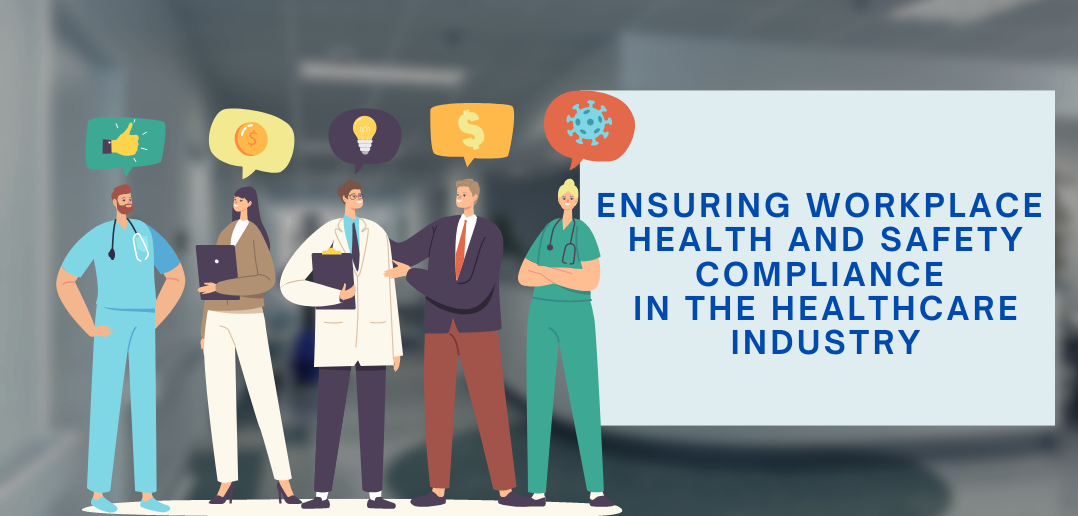Healthcare Compliance

Ensuring Workplace Health and Safety Compliance in the Healthcare Industry
Healthcare industry workplace compliance is essential to meet legal requirements and maintain a safe environment for employees, contractors, visitors, and anyone present on the premises.
Non-compliance not only jeopardises lives but also carries severe legal consequences. However, navigating the complexities of healthcare workplace health and safety compliance can be challenging. Each healthcare workplace is unique, with its own set of risk factors and compliance issues. Successful compliance involves recognising and assessing these specific workplace risks and issues, and developing strategies to mitigate and address them effectively.
While compliance considerations vary among healthcare workplaces, there are shared approaches to planning, risk mitigation, and legal responsibilities related to workplace health and safety. This comprehensive article serves as the ultimate guide to healthcare workplace health and safety compliance. It covers various compliance areas, the relevant laws, and offers strategies for implementing safeguards.
.png?1689652723516)
Understanding Workplace Health and Safety (WHS) Compliance in Healthcare
Complying with Workplace Health and Safety laws and regulations in the healthcare industry entails taking proactive measures to ensure the safety of everyone working in or visiting the healthcare facility. Compliance legislation aims to safeguard not only employees but also customers, clients, contractors, and visitors associated with business operations. At its core, Workplace Health and Safety compliance requires ongoing assessment of the workplace to identify and address safety threats, reducing or eliminating them whenever possible.
While compliance obligations differ based on the healthcare industry and workplace environment, seeking guidance on specific obligations is advisable.
All healthcare businesses share the following obligations:
- Providing a safe working environment
- Mitigating or eliminating identified risks
- Conducting continual assessments to identify evolving risks
- Providing information and training to employees on WHS obligations and compliance
- Verifying safeguards and risk reduction measures when dealing with hazardous substances, materials, or machinery
- Maintaining up-to-date insurance and compensation policies for accidents and injuries
Meeting these compliance obligations not only promotes workplace safety but also benefits the business by reducing downtime and compensation costs while enhancing staff retention and productivity rates.
.png?1689652972711)
Ensuring Corporate Compliance in Healthcare
Complying with Workplace Health and Safety laws in healthcare becomes easier when following a set of basic steps and integrating them into workflow and decision-making processes.
The following checklist can help ensure legal compliance in your healthcare workplace:
- Develop a risk management plan to identify and manage risks and hazards.
- Regularly assess the work environment and procedures to ensure alignment with safety best practices.
- Appoint a safety officer responsible for implementing the plan, assessing risks, and reporting incidents.
- Provide training and safety guidelines to staff during onboarding and at regular intervals.
Workplace Health and Safety Legislation and the Chain of Responsibility
The concept of the Chain of Responsibility has long been applicable in Workplace Health and Safety law, attributing legal liability to individuals within the management chain for any breaches that occur within their area of oversight. While initially focused on heavy goods vehicles and their drivers, many provisions also apply to the broader workplace context.
Recent changes to the Chain of Responsibility have mandated employers to proactively reduce and eliminate risk factors. Previously, legal action could only be pursued after an incident occurred. However, under the new laws, the presence of unaddressed risks alone can lead to legal penalties. To avoid breaching Workplace Health and Safety laws, employers must adopt a more proactive approach.
Common areas where breaches may occur in healthcare workplaces include:
- Contracts: Ensure contracts do not force employees to work longer hours than legally permitted.
- Timings: Set work schedules, travel routes, and job completion times with reasonable goals that do not exceed safe working hours.
- Loads: Ensure shipments and loads comply with weight limits specified by the law and are packaged securely.
- Speed Limits: Ensure drivers adhere to speed limits for the road and vehicles they operate.
.png?1689653691216)
Managing Contractor Risks in Healthcare
Contractors are often necessary in healthcare workplaces to supplement the workforce with temporary staff or specialised skills. However, without proper care, contractors can introduce additional health and safety risks. Unlike regular permanent staff, contractors may not have undergone extensive pre-employment verification or received on-the-job training specific to the business's work environment and associated risks.
To minimise health and safety risks associated with hiring contractors, consider the following guidelines:
- Establish clear minimum requirements for screening applicants.
- Prequalify candidates against requirements, verifying their training and qualifications.
- Conduct drug and alcohol testing.
- Arrange safety training that outlines the specific risks and operational procedures of your healthcare workplace.
- Provide detailed contracts that clearly define the responsibilities and obligations of both parties.
- Verify that contractors have valid insurance for the work required.
The Importance of Risk Minimisation in the Healthcare Workplace
Each year, there are nearly half a million workplace accidents resulting in injuries across the healthcare industry. Tragically, around two hundred of these accidents result in fatalities. However, thanks to tighter legislative controls and increased awareness of risk factors, these numbers are gradually decreasing.
Maintaining a safe workplace is not only a legal requirement with severe penalties for non-compliance but also offers numerous benefits:
- Decreased Downtime: Reducing workplace injuries minimises sick leave and production disruptions, ultimately saving the company money.
- Efficiency: Regular workplace assessments for health and safety risks can identify not only hazards but also inefficiencies in processes. Conducting these assessments allows for the identification and elimination of inefficiencies, saving time and money for the company.
By prioritising risk minimisation in the healthcare workplace, businesses can protect their employees, enhance productivity, and contribute to a safer industry as a whole.
